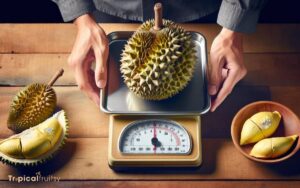What Is a Fruit Called Durian? Unpacking the Mysteries!
Durian is a tropical fruit renowned for its large size, unique odor, and formidable thorn-covered husk.
It possesses a rich, custard-like texture with a complex flavor profile that combines sweet, almond-like tastes with savory undertones, often described as a blend of cheese, almonds, garlic, and caramel.
Often referred to as the “king of fruits” in Southeast Asia, durian is a polarizing fruit with a distinct, pungent smell that can be off-putting for some, while others find it pleasantly aromatic.
Here’s a breakdown of durian’s characteristics:
The fruit is mainly found in countries like Thailand, Malaysia, Indonesia, and the Philippines, and is often eaten fresh, paired with sticky rice, or used in sweet treats like ice cream and pastries.
Despite its controversial scent, durian is cherished by many for its unparalleled taste and is a celebrated delicacy in the culinary landscape of Southeast Asia.
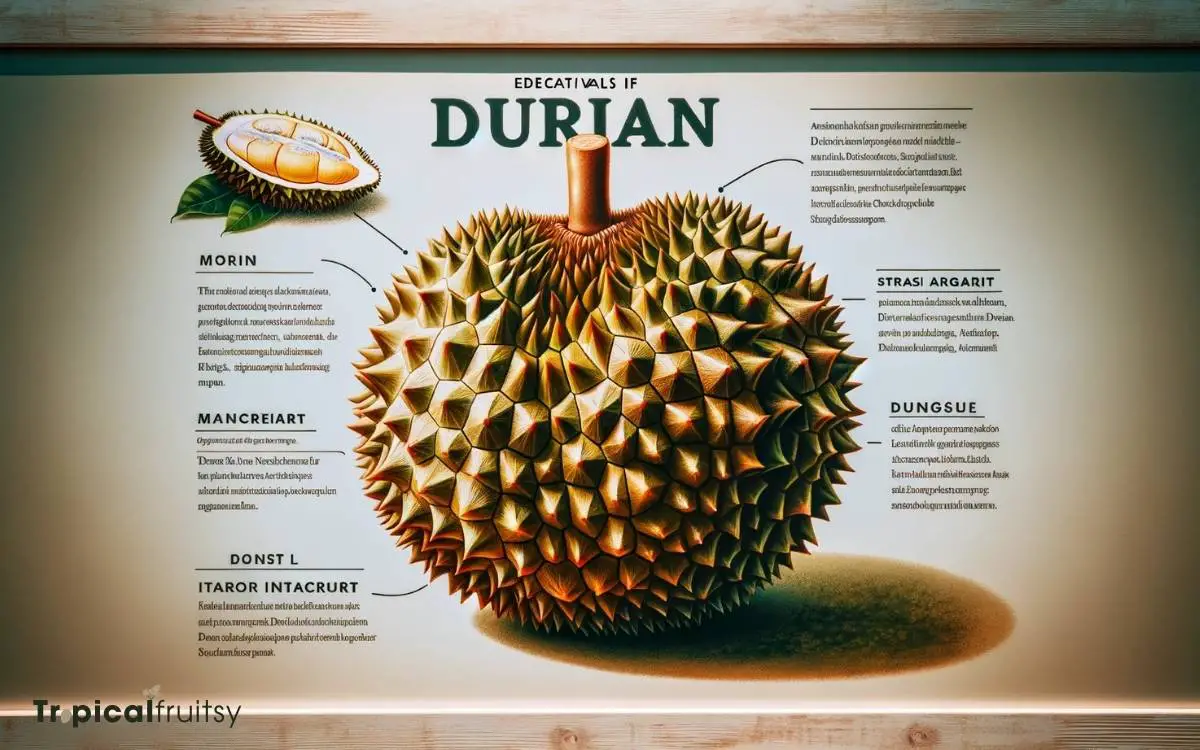
Key Takeaway
Origin and History
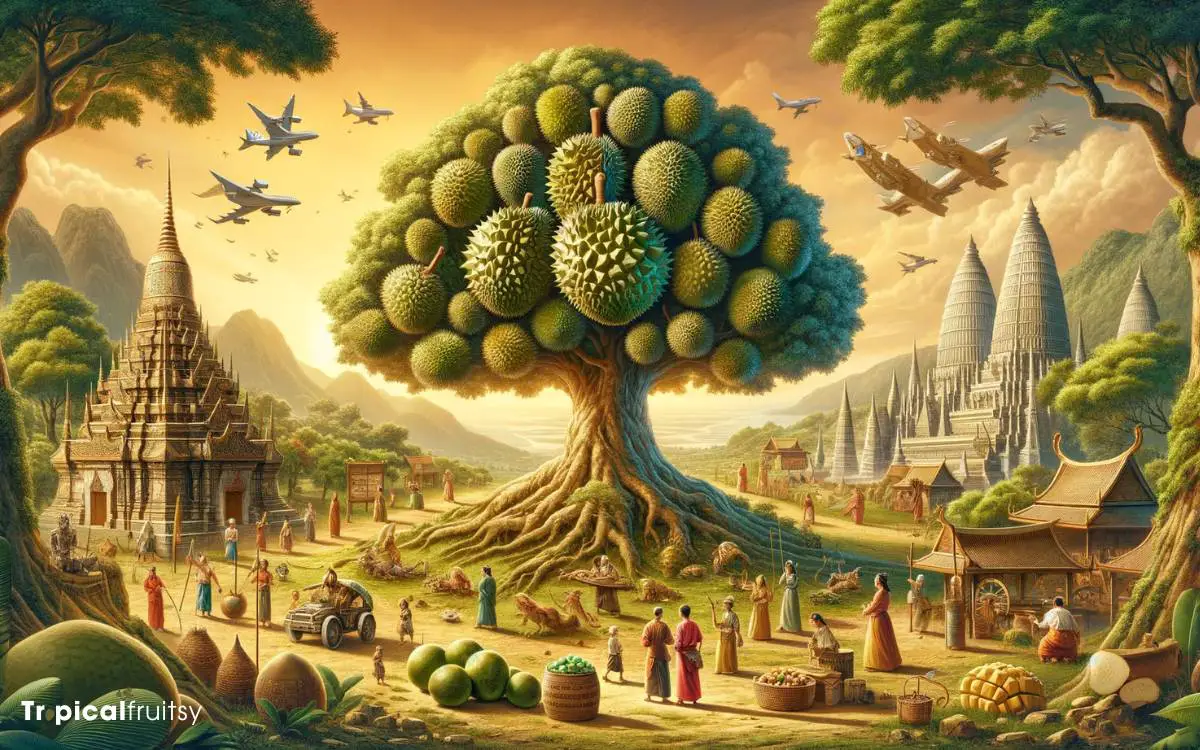
The cultivation of durian, renowned for its distinctive odor and formidable husk, can be traced back to the forests of Borneo and Sumatra in Southeast Asia. This tropical fruit has played a significant role in the region’s cultural and economic history.
Historical records suggest that durian has been known to the local populace for hundreds of years, and its domestication is thought to have occurred several centuries ago.
The etymology of the word ‘durian’ is derived from the Malay-Indonesian language, with ‘duri’ meaning ‘thorn’, referencing the fruit’s spiky exterior.
Over time, its cultivation has spread across Southeast Asia, and it has become a symbol of pride and an agricultural staple in countries such as Thailand, Malaysia, and Indonesia, where it is extensively grown and revered.
Physical Characteristics
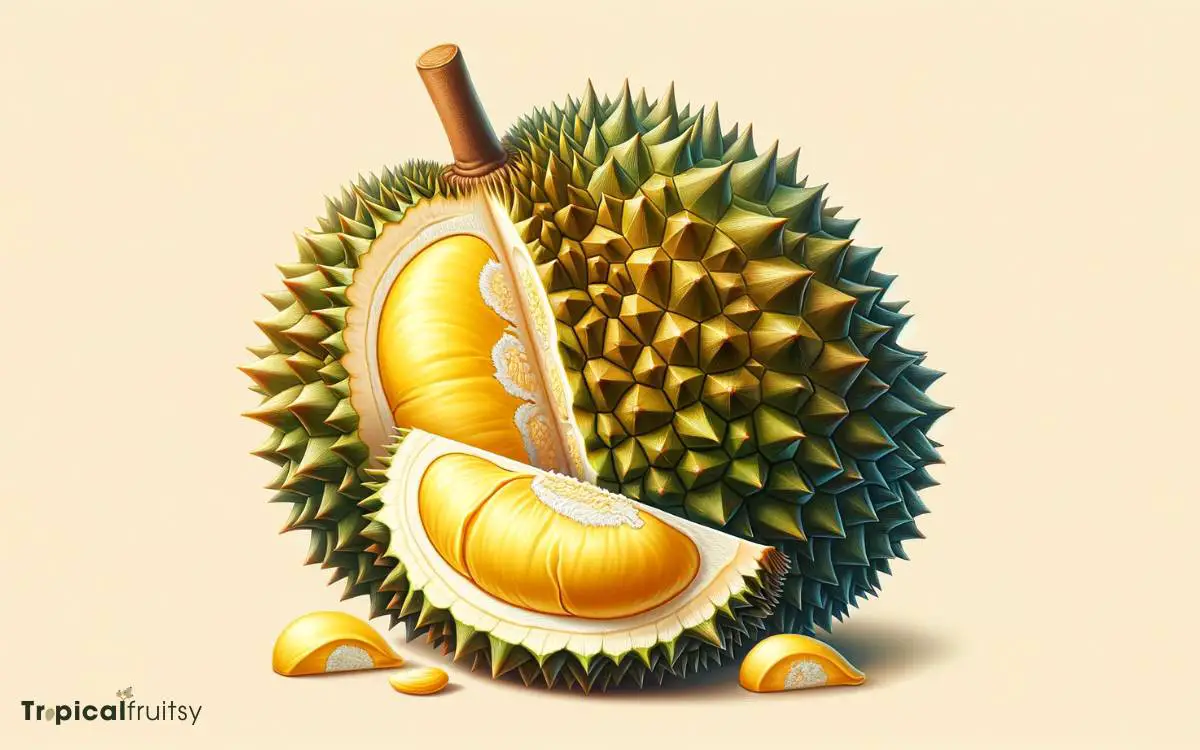
Moving forward from its historical context, the durian fruit is notable for several distinctive physical attributes.
Its formidable spiky outer shell serves as a natural defense mechanism, which, coupled with its significant size and weight, makes it quite unique among tropical fruits.
The interior flesh of the durian is characterized by a creamy texture that contrasts sharply with its armor-like exterior, a factor that significantly influences its culinary applications and consumer handling.
Spiky Outer Shell
Durian’s most distinguishing characteristic is its large, spiky outer shell, which serves as a natural defense mechanism against various predators.
This formidable armor is composed of a tough, fibrous husk, interspersed with sharp, wooden thorns that can measure up to two inches in length.
The density and distribution of these spikes are variable among different durian species, but all serve the primary function of deterring animals from prematurely accessing the soft, edible flesh inside.
From an analytical standpoint, the durian’s shell is a marvel of natural design, optimized for protection while simultaneously aiding in the dispersion of the species by making the fruit attractive to certain large mammals capable of penetrating the shell.
These characteristics underscore the durian’s ecological niche and evolutionary adaptations.
Size and Weight
A durian fruit typically weighs between 1 to 3 kilograms and can be as large as 30 centimeters in diameter, showcasing substantial variation in size among different species.
This variation is not merely incidental but reflects adaptations to diverse ecological niches and seed dispersal methods.
The weight and dimensions of durian fruits are critical factors influencing their marketability and transportability.
| Attribute | Small Durian | Average Durian | Large Durian |
|---|---|---|---|
| Weight | 1 kg | 2 kg | 3 kg |
| Diameter | 15 cm | 22.5 cm | 30 cm |
| Appeal | Manageable | Standard | Impressive |
Analyzing these dimensions provides insight into handling and consumption practices. Smaller durians may be preferred for individual consumption, while larger ones might be favored for shared experiences.
Understanding these characteristics facilitates better consumer education and market positioning for durian producers and vendors.
Flesh Texture
Commonly, the flesh of a durian is known for its creamy texture and custard-like consistency, which contrasts sharply with its spiky outer shell.
When assessing the physical characteristics of durian flesh, several key features should be noted:
- The consistency is typically smooth, without fibrous interruptions, allowing for a homogenous mouthfeel.
- Its viscosity is akin to rich cream, which can vary slightly depending on the ripeness of the fruit.
- The flesh can exhibit a slight resistance when bitten, indicating a fresh and mature durian.
- Upon pressing, there is a yielding nature to the flesh, indicative of the delicate cellular structure that comprises the fruit’s edible part.
These textural elements contribute significantly to the overall sensory experience of consuming durian and serve as a prelude to understanding the fruit’s nutritional profile.
Nutritional Profile
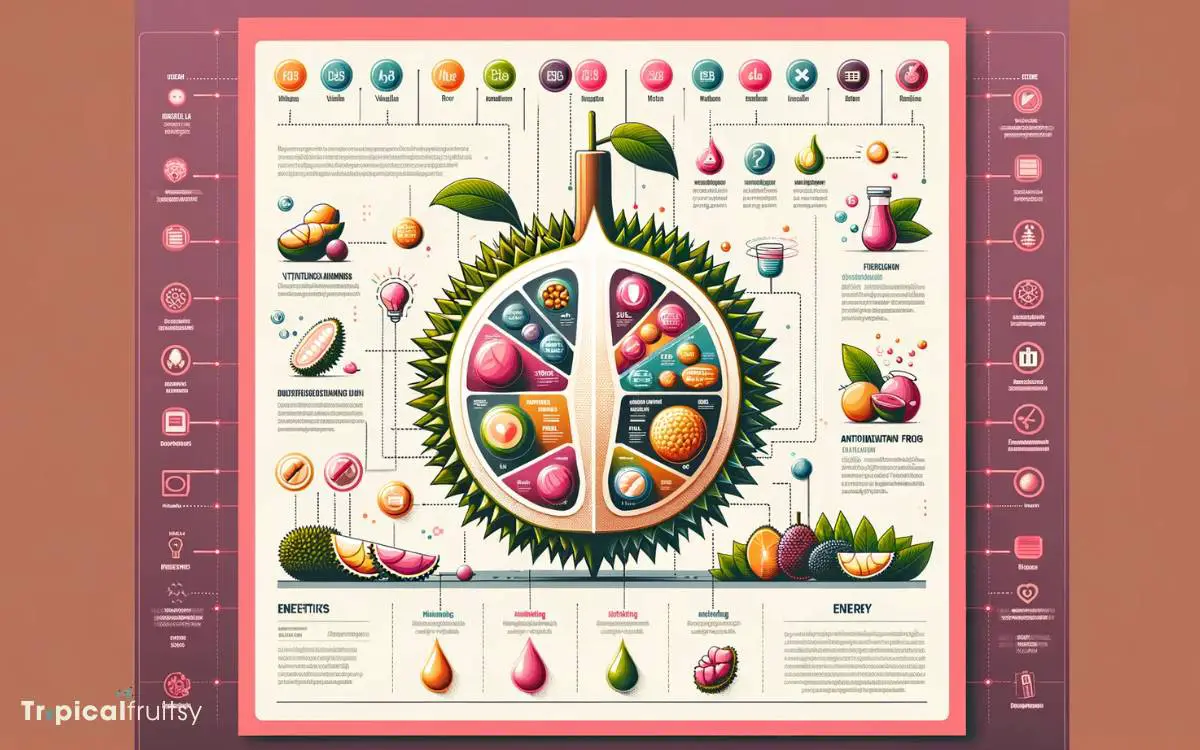
The durian fruit boasts a unique nutritional profile, rich in vitamins, minerals, and dietary fiber. Analyzing its composition reveals that durian is particularly high in vitamin C, which is essential for immune function, skin health, and tissue repair.
It also contains significant amounts of thiamin, riboflavin, niacin, and vitamin B6, all of which play crucial roles in energy metabolism and neurological health.
From a mineral standpoint, durian provides potassium, essential for cardiovascular health and muscle function, as well as magnesium and manganese, which are vital for bone health and metabolic processes.
The dietary fiber present supports digestive health, while the fruit’s high caloric content, primarily from carbohydrates and fats, makes it a dense source of energy.
Consequently, durian’s comprehensive nutritional spectrum underscores its value as a multifaceted dietary component.
The Infamous Aroma
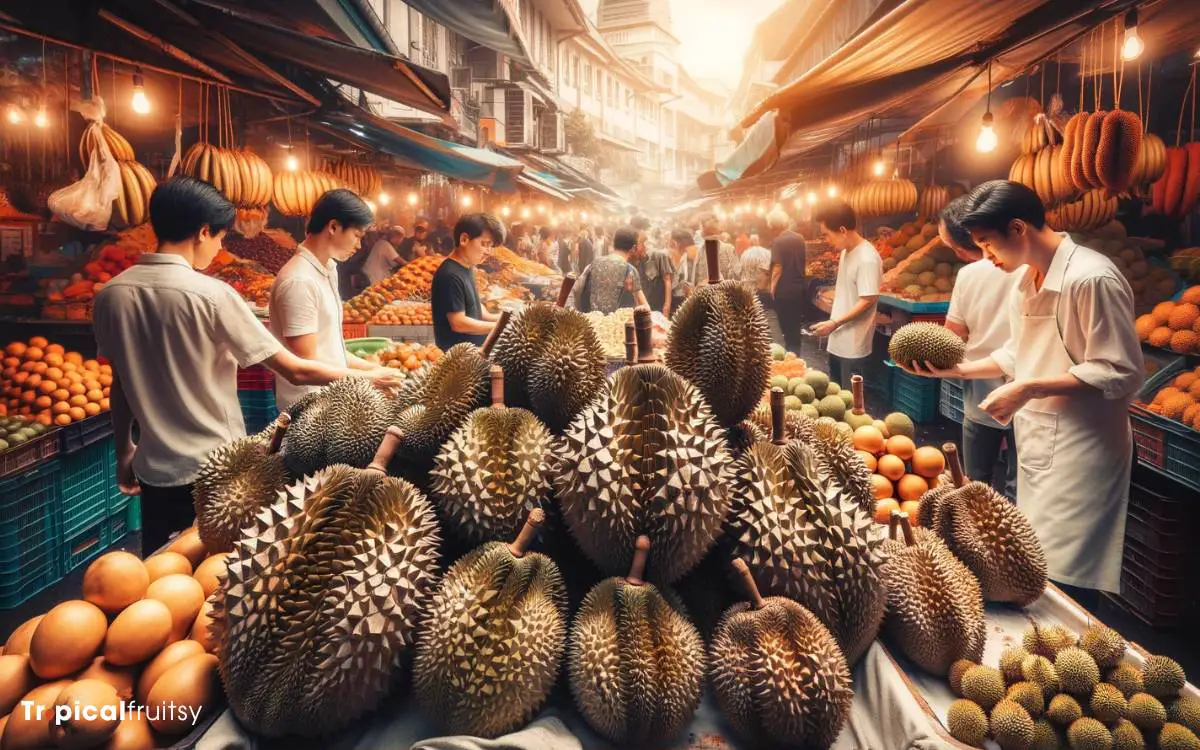
The durian fruit’s aroma is a polarizing characteristic that elicits strong reactions ranging from adoration to intense aversion.
This distinctive scent has even led to the fruit’s prohibition in certain public spaces, such as hotels and mass transit systems, due to its pervasive and lingering nature.
Further examination of the durian’s olfactory impact reveals a complex interplay of volatile compounds that contribute to its unique love-hate scent profile.
Love-Hate Scent Profile
Durian’s polarizing aroma elicits strong reactions, with some individuals drawn to its unique scent, while others are repelled by what they perceive as an overpowering stench.
The complexity of durian’s scent profile can be deconstructed into several contributing chemical compounds:
- Esters and ketones: These chemicals often provide sweet and fruity notes that some find pleasant.
- Sulfur compounds: These contribute to the characteristic smell likened to rotten onions or raw sewage, causing aversion in many people.
- Alcohols: These organic molecules add a yeasty or fermenting aspect to the aroma.
- Acids: Volatile acids can introduce a sharp, vinegary element to the scent bouquet.
Understanding this scent profile underscores the divisive nature of durian odor, leading to its prohibition in certain public spaces.
Banned in Places
Due to its notorious scent, durian is banned in numerous hotels and public transportation systems across Southeast Asia.
The aroma is so pervasive and potent that it can linger, affecting the comfort and experience of others in shared spaces. Analyzing the impact of durian’s scent on various environments has led to the enforcement of restrictions.
| Region | Type of Ban | Rationale |
|---|---|---|
| Singapore | Public Transit | Public comfort |
| Thailand | Hotels | Hospitality standards |
| Malaysia | Airports | Facility cleanliness |
These bans reflect a broader cultural consideration for communal well-being and property maintenance.
In areas where durian is prohibited, signs are often prominently displayed to inform both locals and tourists of the restrictions in place.
The intricate relationship between durian’s pungent aroma and its bans segues into its polarizing role in culinary applications.
Culinary Uses
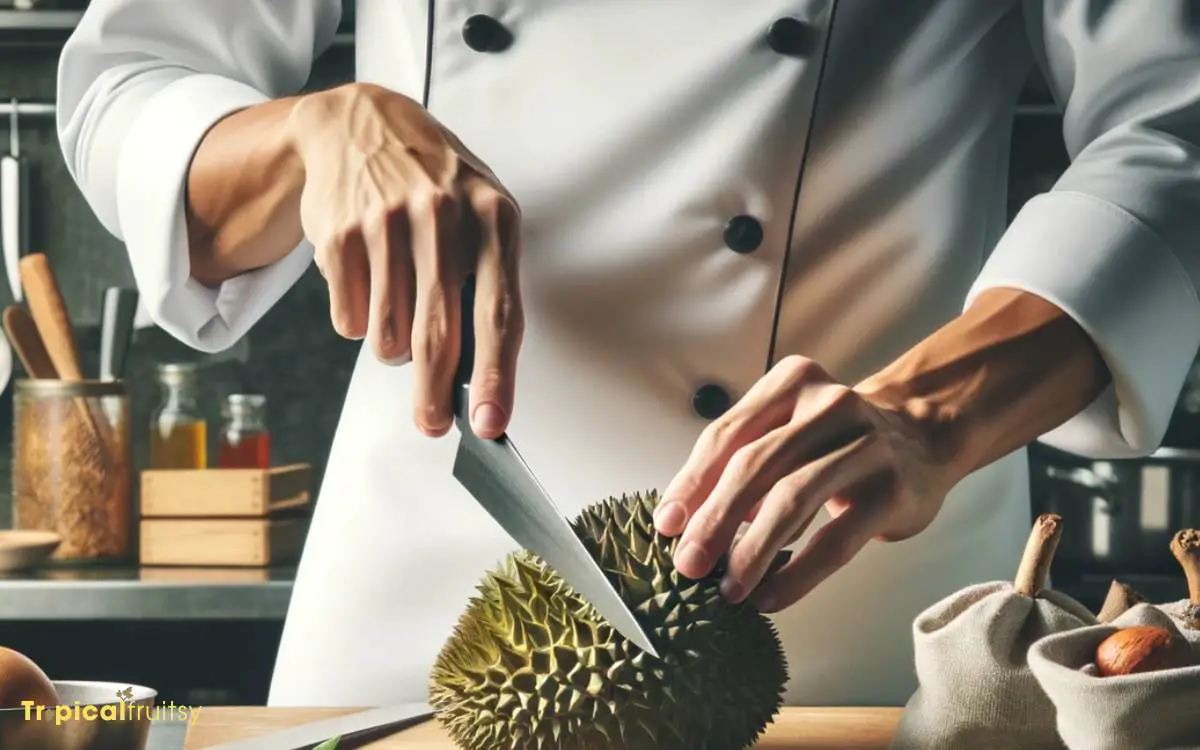
In Southeast Asian cuisine, durian is often celebrated as a versatile ingredient, incorporated into a wide array of dishes from sweet desserts to savory meals.
The fruit’s creamy texture and distinctive taste make it a unique addition to various culinary creations.
Analyzing its use across different food preparations reveals:
- Durian Ice Cream: A popular frozen dessert where durian’s creamy pulp is blended into a rich custard base.
- Durian Cakes and Pastries: Bakers infuse durian flesh into cakes, tarts, and pastries, providing a lush, aromatic flavor.
- Durian Candy and Snacks: Confectioneries produce candies, chips, and rolls that capitalize on durian’s intense sweetness and potent aroma.
- Savory Durian Dishes: Chefs occasionally incorporate durian into savory dishes, adding complexity to sauces, curries, and rice meals.
These culinary explorations showcase durian’s adaptability and its revered status in gastronomy.
Cultural Significance

The durian fruit holds a place of honor in many Southeast Asian cultures, often regarded as the ‘king of fruits’ and celebrated in festivals and culinary traditions.
Its cultural significance extends beyond its unique flavor profile, symbolizing social status, communal relationships, and traditional values. Durian is not merely a fruit but an embodiment of cultural identity and heritage.
To understand its deep-rooted cultural importance, consider the following table:
| Country | Festival/Celebration | Cultural Role |
|---|---|---|
| Thailand | Durian Festival | Tourism and Gastronomy |
| Malaysia | Durian Season | Social Gatherings |
| Indonesia | Durian Harvest Celebrations | Agricultural Significance |
| Singapore | Durian Buffets | Culinary Tourism |
| Philippines | Kadayawan Festival | Indigenous Celebrations |
Tips for First-Timers

While durian’s pungent aroma may be off-putting to some, there are several pointers that first-time tasters should consider to enhance their experience with this unique fruit.
Approaching durian consumption with a methodical strategy can lead to an appreciation of its complex flavor profile.
Here is a concise guide:
- Select Properly: Opt for durians with a firm stem and a relatively mild smell, as these may indicate ripeness without over-fermentation.
- Handling with Care: Use gloves or utensils to handle durian to avoid lingering smells on your hands.
- Pair Wisely: Accompany the fruit with a beverage like coffee or tea, which can complement its rich taste.
- Mindset Matters: Approach the tasting with an open mind, recognizing durian’s acquired taste and significant cultural value.
Conclusion
The durian fruit, with its formidable spiky exterior and richly custard-like interior, stands as a culinary paradox.
Revered and reviled, akin to being draped in a heavy, aromatic cloak of controversy, it provides substantial nutritional benefits despite its polarizing scent.
Its cultural and culinary significance is deeply rooted in Southeast Asian traditions, presenting a formidable gastronomic adventure for the uninitiated, suggesting that the durian’s multifaceted nature demands both respect and a discerning palate.

